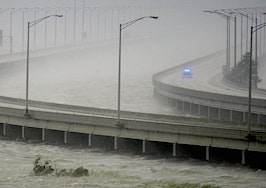- Texas and Florida are considered high-risk states due to their lengthy coastlines.
- New York is a high risk state because of the population density along the coastline.
- Homeowners who don’t live in FEMA zones don’t always carry flood insurance, making them liable for damage costs not otherwise covered in their homeowners’ insurance package.
Agents and owners along the Atlantic and Gulf coasts beware: the total reconstruction cost for homes susceptible to storm damage is pricey — $1.5 trillion in 2016, according to a CoreLogic Storm Surge analysis.
Reconstruction value (RCV) increased year-over-year, the report says, as did the number of households at risk, which now spans more than 6.8 million homes.
However, the 2016 analysis illustrates a decrease in the most extreme category for number of homes at risk and the associated RCV.
“Despite the overall increases in risk, we were glad to see that the number and value of homes in the most extreme and dangerous category actually declined,” Dr. Tom Jeffery, CoreLogic senior hazard risk scientist, said. “It just goes to show the power of how advanced data can improve risk assessment at the property level.”
CoreLogic reviewed 19 states and Washington D.C., as well as 88 metro areas, along the Atlantic and Gulf Coasts. From there, homes were categorized into five risk levels: low, moderate, high, very high and extreme.
On the Atlantic Coast, less than 3.9 million homes are at risk and the RCV is $953 billion. The Gulf Coast has under 2.9 million homes at risk and an RCV of $592 billion.
RCV estimates are based on construction materials and equipment and labor costs, but do not incorporate value of the land. RCV assumes total reconstruction from storm damage. Therefore, flood damage alone could lessen the associated RCV in any state or metro area.
Which states are in jeopardy?
Unsurprisingly, Texas and Florida are considered high-risk states due to their lengthy coastlines. Florida has 2.7 million at-risk homes across all categories, and Texas has 531,169 properties vulnerable to storm damage.
Florida and Texas rank first and third for most homes at risk, and first (over $535 billion) and fifth (over $91 billion) for greatest RCV estimates.
Despite a slimmer coastline, Louisiana ranked second for most at-risk homes (800,521). New Jersey came in fourth (468,823). Both states featured a high RCV, an estimated $184 billion for Louisiana and more than $139 billion for New Jersey.
New York is a high-risk state because of the population density along the coastline. It wasn’t always considered a high-risk zone, yet the total number of homes at risk is 458,730 (fifth place), and the total RCV is more than $177 billion (third place). The impact of Hurricane Sandy revealed the predisposition New York has to storm damage.
Cities with the highest storm risk

CoreLogic
Fifteen core-based statistical areas (CBSAs) comprise 67.3 percent of the 6.8 million at-risk homes, demonstrating how localities play a significant factor in risk assessment.
The Miami CBSA, including Fort Lauderdale and West Palm Beach, has the highest number of at-risk homes at 780,482. The Miami CBSA has an RCV of just under $144 billion. At 719,373 homes, New York City CBSA has fewer properties at risk then Miami, but NYC has a higher RCV of $260 billion.
Tampa nears the highest-risk metros, with 454,746 total homes potentially affected by hurricanes and an RCV of over $80 billion. New Orleans, Virginia Beach and Cape Coral were all toward the top risk zones. These metros displayed more than 300,000 liable properties each.
Houston ranked No. 7 in storm surge risk among metropolitan areas, with 280,112 at-risk homes and $51.8 billion in estimated RCV.
Risk level for the U.S.

CoreLogic
Unfortunately, FEMA flood zones do not base findings on storm severity, CoreLogic says. Because of this, the scope of potential risk is not fully measured by these zones.
Homeowners who don’t live in FEMA zones don’t always carry flood insurance, making them liable for high-damage costs not otherwise covered in their homeowners’ insurance package.













